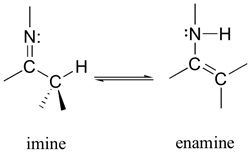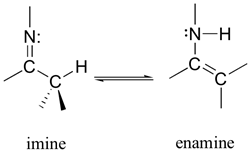
Organic Chemistry (8th Edition)
8th Edition
ISBN: 9780134042282
Author: Paula Yurkanis Bruice
Publisher: PEARSON
expand_more
expand_more
format_list_bulleted
Question
Chapter 16.8, Problem 32P
(a)
Interpretation Introduction
Interpretation:
The mechanisms for the following reactions should be determined.
- 1. The acid-base catalyzed hydrolysis of an imine to a carbonyl compound and a primary
amine . - 2. The acid-base catalyzed hydrolysis of an enamine to a carbonyl compounds and a secondary amine.
Concept introduction:
The chemical compound containing carbon and nitrogen double bond is known as imine.
Enamine is derived by the condensation of an

(b)
Interpretation Introduction
Interpretation:
The reason for the difference in mechanism of two reactions should be given.
Concept introduction:
The chemical compound containing carbon and nitrogen double bond is known as imine.
Enamine is derived by the condensation of an aldehyde and ketone with secondary amine.

Expert Solution & Answer
Want to see the full answer?
Check out a sample textbook solution
Students have asked these similar questions
a. Write the mechanism for the following reactions:1. the acid-catalyzed hydrolysis of an imine to a carbonyl compound and a primary amine2. the acid-catalyzed hydrolysis of an enamine to a carbonyl compound and a secondary amine
b. How do the two mechanisms differ?
Reactions of aldehydes and ketones with amines and amine derivatives
a. Draw reaction with a primary amine forms an imine. Hydrazine and hydroxylamine can also be used; they form a hydrazone and an oxime, respectively.
b. Draw reaction with a secondary amine forms an enamine.
6. The reaction between aniline and nitrous
acid at low temperature yields
A) an N-nitroso amine
B) a diazonium salt
C) a nitrile
D) an amine nitrite salt
7. An organic nitrogen compound, X, gives
ammonia on warming with dilute aqueous
sodium hydroxide, X could be
A) ethanamide B) ethylamine
C) phenylamine D) amino ethanoic acid
Chapter 16 Solutions
Organic Chemistry (8th Edition)
Ch. 16.1 - Give two names for each of the following:Ch. 16.1 - Prob. 2PCh. 16.1 - Name the following:Ch. 16.2 - Prob. 4PCh. 16.4 - What products are formed when the following...Ch. 16.4 - We saw on the previous page that...Ch. 16.4 - a. How many stereoisomers are obtained from the...Ch. 16.4 - Prob. 9PCh. 16.4 - Write the mechanism for the reaction of acetyl...Ch. 16.4 - Prob. 11P
Ch. 16.4 - Show how the following compounds can be...Ch. 16.4 - Prob. 13PCh. 16.4 - Prob. 14PCh. 16.4 - In the mechanism for cyanohydrin formation, why is...Ch. 16.4 - Prob. 16PCh. 16.4 - Prob. 17PCh. 16.4 - Show two ways to convert an alkyl halide into a...Ch. 16.5 - Prob. 20PCh. 16.5 - Prob. 21PCh. 16.5 - Prob. 22PCh. 16.5 - Prob. 23PCh. 16.6 - Prob. 24PCh. 16.7 - What reducing agents should be used to obtain the...Ch. 16.7 - Prob. 26PCh. 16.8 - Prob. 27PCh. 16.8 - Prob. 28PCh. 16.8 - Prob. 29PCh. 16.8 - The pKa of protonated acetone is about 7.5. and...Ch. 16.8 - Prob. 31PCh. 16.8 - Prob. 32PCh. 16.8 - Prob. 33PCh. 16.8 - Excess ammonia must be used when a primary amine...Ch. 16.8 - The compounds commonly known as amino acids are...Ch. 16.9 - Hydration of an aldehyde is also catalyzed by...Ch. 16.9 - Which ketone forms the most hydrate in an aqueous...Ch. 16.9 - When trichloroacetaldehyde is dissolved in water,...Ch. 16.9 - Which of the following are a. hermiacetals? b....Ch. 16.9 - Prob. 40PCh. 16.9 - Explain why an acetal can be isolated but most...Ch. 16.10 - Prob. 42PCh. 16.10 - Prob. 43PCh. 16.10 - What products would be formed from the proceedings...Ch. 16.10 - a. In a six-step synthesis, what is the yield of...Ch. 16.10 - Show how each of the following compounds could be...Ch. 16.12 - Prob. 47PCh. 16.13 - Prob. 49PCh. 16.14 - Prob. 50PCh. 16.15 - Prob. 51PCh. 16.16 - Prob. 52PCh. 16 - Draw the structure for each of the following: a....Ch. 16 - Prob. 54PCh. 16 - Prob. 55PCh. 16 - Prob. 56PCh. 16 - a. Show the reagents required to form the primary...Ch. 16 - Prob. 58PCh. 16 - Prob. 59PCh. 16 - Using cyclohexanone as the starting material,...Ch. 16 - Propose a mechanism for each of the following...Ch. 16 - Show how each of the following compounds can be...Ch. 16 - Fill in the boxes:Ch. 16 - Prob. 64PCh. 16 - Identify A through O:Ch. 16 - Prob. 66PCh. 16 - Prob. 67PCh. 16 - Prob. 68PCh. 16 - How many signals would the product of the...Ch. 16 - Prob. 70PCh. 16 - Prob. 71PCh. 16 - Prob. 72PCh. 16 - Prob. 73PCh. 16 - Prob. 74PCh. 16 - Prob. 75PCh. 16 - Prob. 76PCh. 16 - Prob. 77PCh. 16 - Prob. 78PCh. 16 - Draw structure for A-D for each of the following:Ch. 16 - Prob. 80PCh. 16 - a. Propose a mechanism for the following reaction:...Ch. 16 - Prob. 82PCh. 16 - A compound gives the following IR spectrum. Upon...Ch. 16 - How can be following compounds be prepared from...Ch. 16 - Prob. 85PCh. 16 - Prob. 86PCh. 16 - Prob. 87PCh. 16 - In the presence of an acid catalyst, acetaldehyde...Ch. 16 - Prob. 89PCh. 16 - Prob. 90PCh. 16 - Prob. 91PCh. 16 - A compound reacts with methylmagnesium bromide...Ch. 16 - Show how each of the following compounds can be...Ch. 16 - Prob. 94PCh. 16 - The pKa values of the carboxylic acid groups of...Ch. 16 - The Baylis-Hillman reaction is a DABCO...Ch. 16 - Prob. 97PCh. 16 - Prob. 98P
Knowledge Booster
Similar questions
- Draw the major product of this reaction. Ignore inorganic byproducts and the amine side product. 1. NaOH, heat N 1 2. Neutralizing work- uparrow_forwardDraw the major product of this reaction. Ignore inorganic byproducts and the amine side product. 1. NaOH, heat 2. Neutralizing work-up Select to Drawarrow_forward1. Which of the following amines would make an imine if reacted with an aldehyde or ketone? A B e. Which of the following moleculo C NH₂ AN Darrow_forward
- What two amides are obtained from the reaction of acetyl chloride with an equivalent of ethylamine and an equivalent of propylamine? a. Why is only one amide obtained from the reaction of acetyl chloride with an equivalent of ethylamine and an equivalent of triethylamine?arrow_forwarda. What two amides are obtained from the reaction of acetyl chloride with an equivalent of ethylamine and an equivalent of propylamine?b. Why is only one amide obtained from the reaction of acetyl chloride with an equivalent of ethylamine and an equivalent of triethylamine?arrow_forwardi. Synthetize nicotine from nicotinic acidarrow_forward
- Which amines cannot be prepared by a Gabriel synthesis? Explain your choices. NH2 NH2 NH2 а. b. C. d.arrow_forward1. What amine and what carbonyl compound are required to make the following molecule: N.arrow_forwardChapter 1 (Carbonyl compounds I) Explain how the class I carbonyl compound reacts? What will be the product when ethylamine and propyl amine reacts with acetyl chloride? Why only one amide obtained after the reaction of acetyl chloride with a mixture of ethylamine and trimethylamine? Excess amine is required in the reaction of acetyl chloride with amine whereas excess alcohol is not required in the reaction of acetyl chloride and alcohol. Why? List the following ester in order of decreasing reactivities towards hydrolysis with reason: Methyl benzoate, p-nitro methyl benzoate and p-methoxy methyl benzoate The reaction of an ester with an amine is not as slow as the reaction of an ester with water or an alcohol. Explain with reason. Explain why the rate of aminolysis of an ester cannot be increased by H+, OH- or OR-. How can you activate the carboxylic acid? Is acid catalyzed hydrolysis of acetamide a reversible or an irreversible reaction. Explain. Chapter 2 (Carbonyl compounds II)…arrow_forward
- 1. Rank the following nitrogens or amines in order of decreasing basicity (strongest to weakest, strongest = 1) a) N 'NH2 compare the basicity of three nitrogen in 1-methylhistamine b) F. 'NH2 'NH2 'NH2arrow_forwardWhich of the following reactions will not produce N-methylbutanamine? O a. Reduction of N-methylbutanamide with LIAIH4. O b. The reaction of butanoyl chloride with methanamine. OC. The reaction of methanamine with 1-butyl bromide and subsequent reaction with a strong base. O d. The reaction of 1-butanamine with methyl bromide and subsequent reaction with a strong base.arrow_forward14. What products result from the reaction between water and the following amine: a. butyl ethyl methyl ammonium ion + OH+ b. butyl ethyl methyl ammonium ion + H3O+ c. butyl ethyl methyl ammonium ion + H3O d. butyl ethyl methyl ammonium ion + OH- e. butyl ethyl methyl ammonium ion + H2Oarrow_forward
arrow_back_ios
SEE MORE QUESTIONS
arrow_forward_ios
Recommended textbooks for you
 Chemistry for Today: General, Organic, and Bioche...ChemistryISBN:9781305960060Author:Spencer L. Seager, Michael R. Slabaugh, Maren S. HansenPublisher:Cengage Learning
Chemistry for Today: General, Organic, and Bioche...ChemistryISBN:9781305960060Author:Spencer L. Seager, Michael R. Slabaugh, Maren S. HansenPublisher:Cengage Learning
 Organic Chemistry: A Guided InquiryChemistryISBN:9780618974122Author:Andrei StraumanisPublisher:Cengage Learning
Organic Chemistry: A Guided InquiryChemistryISBN:9780618974122Author:Andrei StraumanisPublisher:Cengage Learning Organic ChemistryChemistryISBN:9781305580350Author:William H. Brown, Brent L. Iverson, Eric Anslyn, Christopher S. FootePublisher:Cengage Learning
Organic ChemistryChemistryISBN:9781305580350Author:William H. Brown, Brent L. Iverson, Eric Anslyn, Christopher S. FootePublisher:Cengage Learning

Chemistry for Today: General, Organic, and Bioche...
Chemistry
ISBN:9781305960060
Author:Spencer L. Seager, Michael R. Slabaugh, Maren S. Hansen
Publisher:Cengage Learning


Organic Chemistry: A Guided Inquiry
Chemistry
ISBN:9780618974122
Author:Andrei Straumanis
Publisher:Cengage Learning

Organic Chemistry
Chemistry
ISBN:9781305580350
Author:William H. Brown, Brent L. Iverson, Eric Anslyn, Christopher S. Foote
Publisher:Cengage Learning